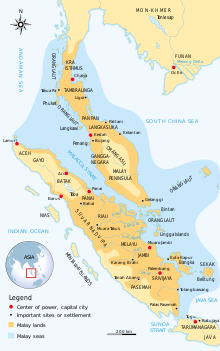
Back Lamri ACE Lamuri Esperanto Lamri ID ലാമുറി സാമ്രാജ്യം Malayalam இலமூரி சுல்தானகம் Tamil ลัมบรี Thai 南浡里 Chinese

Lamuri, Lamri,[1] or Lambri[2] was a kingdom in northern Sumatra, Indonesia recorded from the 9th century until the early 16th century. The area was inhabited by Hindu population around the seventh century.[3] There is also evidence of Buddhism.[4] The region is also thought to be one of the earliest places of arrival of Islam in the Indonesian archipelago, and in its later period its rulers were Muslims.
Lambri is generally considered to be located in the Aceh province near Banda Aceh. Its location has been suggested to be in today's Lambaro to the west of Bandar Aceh where submerged ruins of buildings and tombstones have been found,[2] although some now associate Lambri with Lam Reh to the east of Aceh where there are ancient tombstones, and where significant archaeological material from between the 13th and 15th centuries are found.[1][5] Accounts of Lambri have been given in various sources from the 9th century onwards, and it has been proposed that accounts of Lambri between the 9th and 13th centuries referred to a broad stretch of North Sumatran coast, but from the 13th to 15th centuries Lambri was centered in Lam Reh.[1]
Lambri is believed to have been partially destroyed by a tsunami in 1394.[1] There are no references in historical texts to Lambri after the mid-16th century, and it is thought to have become absorbed into the Aceh Sultanate by the early 16th century.[6]
- ^ a b c d Daly P, Edwards McKinnon E, Feener RM, Tai YS, Ardiansyah, Parnell A, Nizamuddin, Ismail N, Sieh K, Majewski J (2019). "The Historic Trading Port of Lamri on the North Sumatran Coast". Bulletin de l'École française d'Extrême-Orient. 105: 115-144. JSTOR 26921087.
- ^ a b E. Edwards McKinnon (October 1988). "Beyond Serandib: A Note on Lambri at the Northern Tip of Aceh". Indonesia. 46 (46): 102–121. doi:10.2307/3351047. hdl:1813/53892. JSTOR 3351047. Archived from the original on 2012-06-17. Retrieved 2014-03-03.
- ^ "Indra Patra Fortress". Indonesia Tourism. Archived from the original on 2010-11-24. Retrieved 2014-12-03.
- ^ "Situs Lamuri Dipetakan". Banda Aceh Tourism. 28 September 2014. Archived from the original on 19 January 2015. Retrieved 3 December 2014.
- ^ Suprayitno (2011). "Evidence of the Beginning of Islam in Sumatera: Study on the Acehnese Tombstone" (PDF). TAWARIKH: International Journal for Historical Studies. 2 (2). Archived from the original (PDF) on 2013-12-28.
- ^ Cite error: The named reference
sumawas invoked but never defined (see the help page).